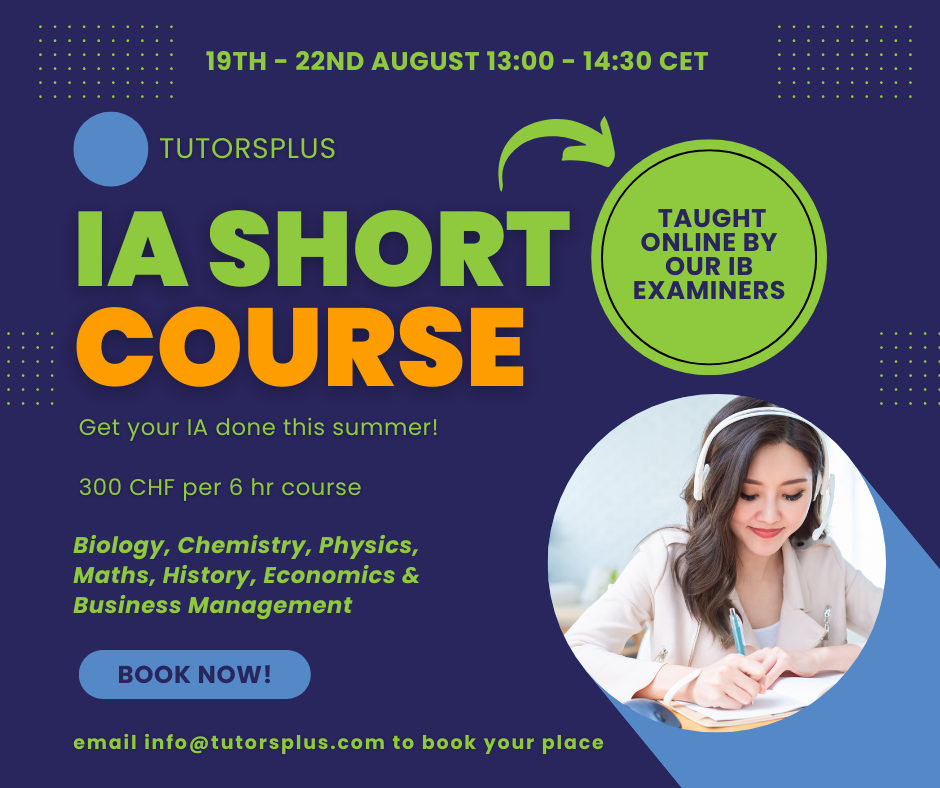IB ESS IA Internal Assessment: Key Strategies to Get a High Score

Tony is a UK-qualified IBDP teacher. With over 20 years of experience, he has taught IB, IGCSE, and A-Level. Currently based in Switzerland, he teaches ESS and holds a BSc in Microbiology from Imperial College London as well as a Master’s in Education from UCL’s Institute of Education. In addition, he supervises IB ESS IAs and Extended Essays.
Article reviewed & updated by Tony, 19th June 2025
Need help with IB ESS?
__________________________________________________________________________________________
Are you aiming to excel in your IB Environmental Systems and Societies Internal Assessment (IA)? We’ve got you covered. In this article, we’ll discuss the key strategies to help you get that top score. With Tony’s help we’ll cover everything from picking the right topic to analyzing and evaluating your findings. With advice from an experienced IB teacher, you’ll learn how to structure your IA, craft a research question that stands out, and use the right methods to impress your examiners.
What is IB Environmental Systems and Societies (ESS) IA?
The IB Environmental Systems and Societies (ESS) Internal Assessment (IA) is a big part of your IB Diploma journey. It allows you to dive into environmental issues that matter to you and apply scientific methods to understand and address them. You’ll get to choose a topic that interests you, conduct research, and present your findings in a clear, well-organised report.
Tony notes that his students often pick ESS because it blends science and society, meaning students explore the topic from both natural and social science perspectives.
IB ESS IA: Structure and Format
The IB ESS IA has a clear structure to help you stay organised and focused. Here’s what you need to include:
Title Page
This is where you put your IA title, research question, word count, and the session for submission. Keep it neat and clear.
Introduction
Here, you’ll give a bit of background on the environmental issue you’re studying. Why is this topic important? How are you going to approach it in your research? This is the WHAT, WHY and HOW of the IA. What are you going to write about, WHY is it interesting to explore, HOW will you get evidence to support any claims you make (otherwise known as the methodology)? Will you do online literature reviews, interviews, surveys, filed work etc? Choose methods that are appropriate to gathering robust evidence.
Research Question
This is the heart of your IA. Make sure your question is focused and specific. It should guide the whole investigation. Tony highlights a pitfall to avoid: “Make sure it is not too broad as you can’t answer wide ranging questions in 3000 words. Pick something with enough focus that you will be able to address it correctly in the word count”.
Methodology
In this section, explain how you will collect your data. Ensure your method is repeatable, so someone else could follow your steps and get the same results. Tony explains it using a cake baking analogy. “Imagine baking a cake by following a recipe. Every step must be completely unambiguous and clear so that anyone who reads it ends up with the same cake”. Your method must be clear, covering every step so that anyone could repeat what you have done.
Results
Present your data clearly whether that’s in tables, graphs, or calculations. Just make sure it’s organised. Tony also reminds students to “check all tables have clear headings with correct units, as this is a common error which leads to lost marks”.
Analysis and Evaluation
You dive into your data and think about its meaning here. What patterns or trends do you see? And don’t forget to evaluate how well your research method worked.
Firstly, make sure you state very clearly in one sentence what relationship you have noted between your variables. Don’t over complicate it at this stage. Something like “as the temperature increases the rate of growth in mm/day increases in the range from 10 degrees until 30 degrees about then appears to plateau.” After this statement, you can unpack it in much more detail but it’s amazing how many students forget to state the basic relationship they have uncovered.
Conclusion
Wrap it all up here. Summarise your findings and offer some solutions or recommendations based on your research. This is how students can approach this important section:
- Make sure you refer to your data as supporting evidence for your conclusion.
- Talk about how well your data supports (or not) your hypothesis.
- If you only have weak supporting evidence, don’t be afraid to say so. It’s far better to show you understand the limitations you have than to try and show a powerful correlation.
- Oddly, students think that only beautiful straight lines pointing upwards are acceptable and are expected of them. That is not “real” science and should not influence how you look at what you interpret in your results.
References
List all the sources you used and cite them properly. It’s important to give credit where credit is due. Choose one referencing format and stick to it. MLA formatting or similar are acceptable.
By following this approach, you’ll ensure your IB ESS IA is well-organised, clear, and you won’t drop marks unnecessarily for using the wrong structure..
IB ESS IA: Assessment Criteria
The IB assesses your IA based on the following key criteria:
- Identifying the Context: 6 marks (20%)
- Planning: 6 marks (20%)
- Results, Analysis & Conclusion: 6 marks (20%)
- Discussion & Evaluation: 6 marks (20%)
- Applications: 3 marks (10%)
- Communication: 3 marks (10%)
Each of these focuses on a different part of your research. You’ll need to clearly define the context of your study, plan your methodology carefully, and then analyse and discuss your results with critical thinking.
How to Choose IB ESS IA Topic Ideas
Selecting the right topic for your ESS IA is a big step toward success, and it can set you up for a great project. Let’s walk through a few tips to help you pick a topic that ticks all the boxes:
Think About What Interests You
Start with what excites you. Whether it’s pollution in your local area, the decline of certain species, or the effects of climate change, choose a topic you genuinely care about. This will keep you motivated and make the research process much more enjoyable.
Link It to Local and Global Issues
Your topic should be relevant both locally and globally. Choosing something that impacts the world on a larger scale is excellent, but try to make it something you can observe or measure in your environment. This way, you can connect your findings to real-world challenges.
Make Sure It’s Feasible
Think about the time you have and the word count limits. Choose a question that you can answer within these constraints. Aim for a topic that allows you to collect enough data for meaningful conclusions without getting too complex.
Check if the Data is Available
Ensure that you have access to the data you need. Whether collecting primary data through experiments or surveys or using secondary data from reliable sources, ensure the information is easy to gather and supports your investigation.
Choosing the right topic doesn’t have to be stressful. Take your time and pick something that excites you, fits within your scope, and has the data you need. This is your chance to dive into an environmental issue you care about, so make it count!
Key Strategies to Get a High Score in Your IB ESS Internal Assessment
Aiming for a high score in your IB ESS IA is not just about following the structure. You also need to approach your research clearly, scientifically, and methodically. Here are some strategies that will help you stay on track:
Create a Clear and Focused Research Question
Your research question needs to be specific and focused. If your question is too broad, you’ll struggle to answer it fully. Keep it manageable. For example, instead of asking, “How does pollution affect ecosystems?” narrow it down to something more specific like, “How does the concentration of nitrogen dioxide in urban areas affect the biodiversity of local plants?”
Relate Your Question to Environmental Issues
Make sure your research connects to a larger environmental issue, whether local or global. Think about how your question fits into the bigger picture. For example, consider how different communities or industries are impacted differently if you’re studying pollution. This will help you meet the criteria for understanding the multiple perspectives involved, and if you don’t you will drop significant marks

Link Your Study to Global and Local Issues
Your research must be relevant both locally and globally. Relating your findings to global challenges, like climate change or habitat loss, will make your work more impactful and help demonstrate its significance.
Apply a Scientific and Interdisciplinary Approach
Remember, ESS is all about combining science with societal perspectives. While your data collection will be scientific, consider the social, political, and economic implications of your findings. Taking this interdisciplinary approach will make your research stand out.
Design a Well-Structured Research Plan
A solid plan will keep you organised and on track. Break down your research into manageable steps and make sure that each one is repeatable. Think of it like following a recipe. It should be clear, step-by-step instructions will ensure everything runs smoothly.
Use Reliable Methods for Data Collection
Data collection should be systematic and reliable. Whether you’re conducting experiments, surveys, or using secondary data, make sure that your methods can be repeated. Tony suggests the “5×5 rule”. You need at least five trials for each independent variable value to ensure your data is reliable.
Use Stats and Visuals to Explain Findings
Charts, graphs, and tables make your findings easier to understand and can really help highlight trends and patterns in your data. Be sure to label everything clearly and interpret your visuals concisely. This will make your findings more accessible and easier to follow.
Consider Multiple Perspectives and Implications
Environmental issues often affect different groups in various ways, so consider multiple perspectives. Think about how different communities, industries, or ecosystems are impacted by the issue you’re studying. This will demonstrate your critical thinking and help you evaluate the broader implications of your research.
Relate Findings to ESS Concepts
Your research should align with key ESS concepts like sustainability, ecosystems, and human impact. By grounding your findings in these concepts, you’ll better understand the subject and ensure your work aligns with the IB’s expectations.
Follow a Logical IA Structure
A clear and logical structure is crucial for your IA. Ensure your report flows well, from your introduction and research question to your conclusion and recommendations. Keep everything well-organised to help the examiner follow your argument easily.
Be Clear and Concise
Don’t overcomplicate things. While your IA may involve detailed research, express your ideas clearly and concisely. This will help you stay within the word limit and make it easier for the examiner to understand your points.
Show a Personal Connection to the Research
Your IA should reflect your personal interest in the topic. When you show a personal connection, your research feels more authentic and engaging. It also helps you stand out, showing you’re genuinely invested in your work. This personal touch can make a big difference to the examiner.
By following these strategies, you’ll be well on your way to completing a strong and impactful IB ESS IA. Stay focused, stay organised, and keep your passion for the topic front and centre. It will make all the difference.
Common Pitfalls in an IB Environmental Systems and Societies IA to Avoid
To achieve a high score, here are some common mistakes to watch out for:
Weak Research Question
Make sure your research question is focused and specific. If it is too broad or vague, you won’t be able to answer it fully, which could cost you marks. Keep it manageable so you can explore the topic in detail.
Poor Data Collection Methods
You need reliable methods to collect enough data to make meaningful conclusions. Remember the 5×5 rule. This will ensure your data is solid and you have enough to work with.
Overly Complex Experiment
Don’t make your experiment more complicated than necessary. Keep it simple! Focus on what’s essential, and be mindful of the time constraints.
Ignoring Limitations
Every investigation has limitations, and it’s important to recognise them. Don’t shy away from discussing the weaknesses in your methods or results. This will show a thoughtful and critical approach in your evaluation section.
Evaluation Lacking Critical Thinking
Don’t just list your results. Dig into them. Critically evaluate what worked, what didn’t, and what could be improved in future studies. This shows depth and understanding.
Weak Conclusion
Your conclusion should clearly summarise your findings and offer real solutions or recommendations. Avoid being vague and make sure it answers the research question directly.
By keeping these points in mind, you’ll be well on your way to producing a top-quality IA.
Enhance Your IB ESS IA Skills with Our Expert Tutors
Looking to improve your IB ESS IA? Our skilled tutors are here to support you at every stage, from choosing the ideal topic to polishing your final report. We provide personalised guidance, resources, and feedback to help you achieve the top score you deserve.
We understand IBB ESS IA can be overwhelming, but you don’t have to do it alone. At TutorsPlus, we recognise the importance of your Internal Assessment and are committed to guiding you through each step. Whether you need help finding the right topic, fine-tuning your methodology, or reviewing your structure and content, our experienced IB ESS tutors are ready to help you succeed.
Following these key strategies and avoiding common mistakes will increase your chances of achieving a high score in your IB ESS Internal Assessment. Stay focused, organised, and systematic throughout the process, and you’ll be on track for success!
We are happy to read genuine feedback from parents who trust us with their child’s IB learning like Anne:
“My daughter works with 3 different tutors from TutorsPlus each week to support her 3 high level IB classes and we are both impressed with how knowledgeable and passionate they are about teaching. They take the time to understand my daughter’s learning style and make complex concepts feel more manageable. They are punctual, and scheduling is very easy. I highly recommend TutorsPlus for anyone looking for an IB tutor.”
If you need expert support, don’t hesitate to reach out to us. Contact us at +41 022 731 8148 or . With the support of TutorsPlus, you can transform your Internal Assessment into an outstanding success.














